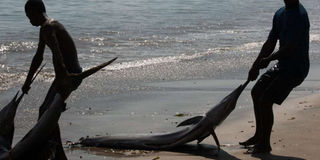Offshore fish farming may be the answer to Kenya's malnutrition

Malindi fishermen display white snappers and large blue marlins. Harvesting fish and shellfish from offshore farms could help provide essential protein to an expanding global population. PHOTO| FILE| NATION MEDIA GROUP
Harvesting fish and shellfish from offshore farms could help provide essential protein to an expanding global population.
Suitable open-sea zones have the potential to yield 15 billion tonnes of fish every year, more than 100 times of the current worldwide seafood consumption, researchers reported in Nature Ecology & Evolution.
Many regions, especially Africa and Asia, depend on fish for protein, but severe pollution, rising costs, and intense competition for shoreline real estate mean that production cannot expand indefinitely. That leaves the deep blue sea, or at least territorial waters up to 650 feet deep — the practical limit for anchoring commercial farms. Oceans represent an immense opportunity for food production, yet the open ocean environment is largely untapped as a farming resource.
HIGHEST POTENTIAL
The researchers divvied up the ocean into a grid, excluding areas that were too deep or already given over to oil extraction, marine parks or shipping lanes. Some 11.4 million square kilometres of ocean could be developed for fish, and 1.5 million square kilometres for bivalves, such as mussels. “Nearly every coastal country has high marine aquaculture potential and could meet its own domestic seafood demand ... using only minute fraction of its ocean territory,” the authors said. Many of the countries with the highest potential — Indonesia, India and Kenya among them — are also predicted to experience sharp increases in population.



